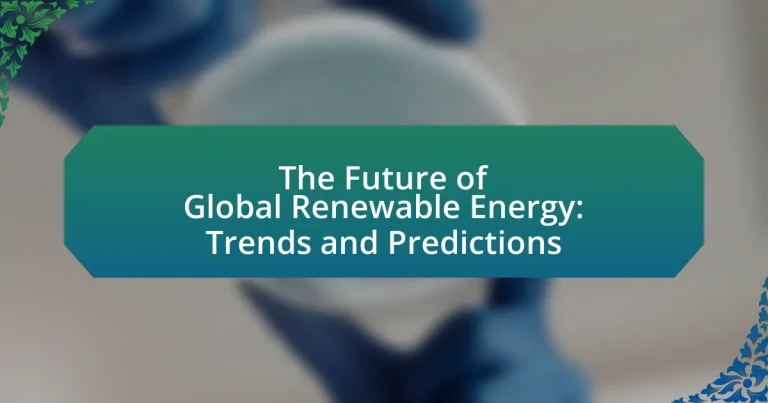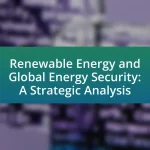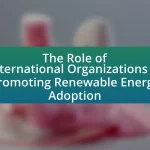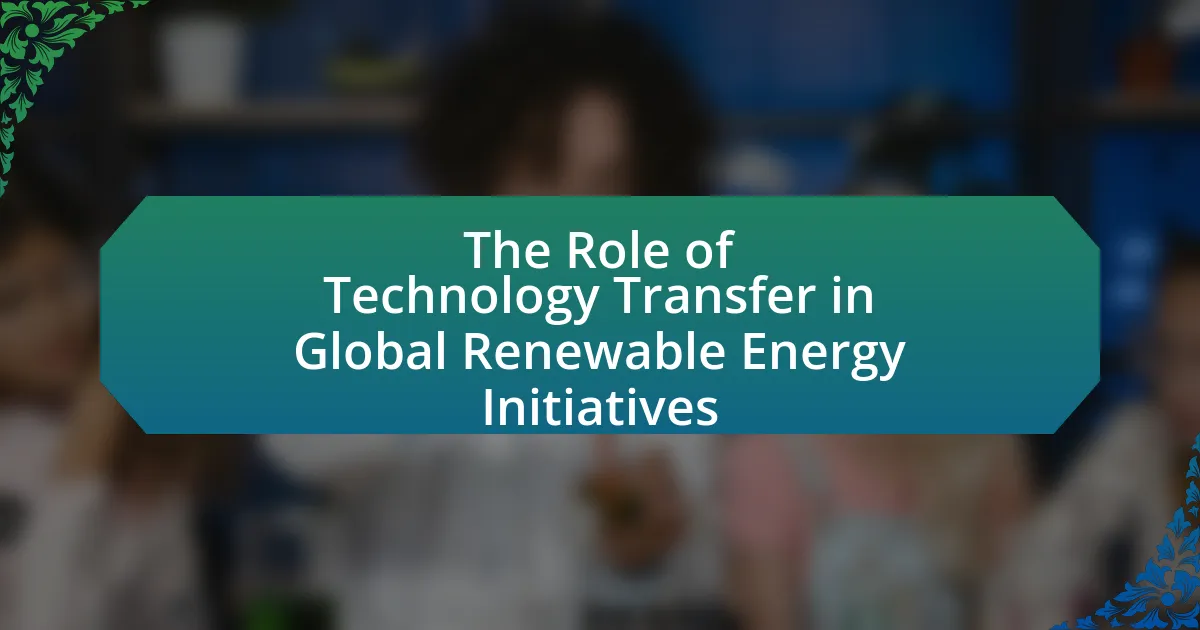The article focuses on the future of global renewable energy, highlighting current trends and predictions in the sector. It details the significant growth in solar and wind energy adoption, driven by technological advancements and decreasing costs, with solar power capacity increasing by 24% and wind energy by 13% in 2022. The article also examines the factors influencing renewable energy adoption, including government policies, technological innovations, and economic considerations. Furthermore, it discusses the expected advancements in renewable technologies, the challenges the sector may face, and the implications for global economies and industries as the world transitions towards sustainable energy sources.
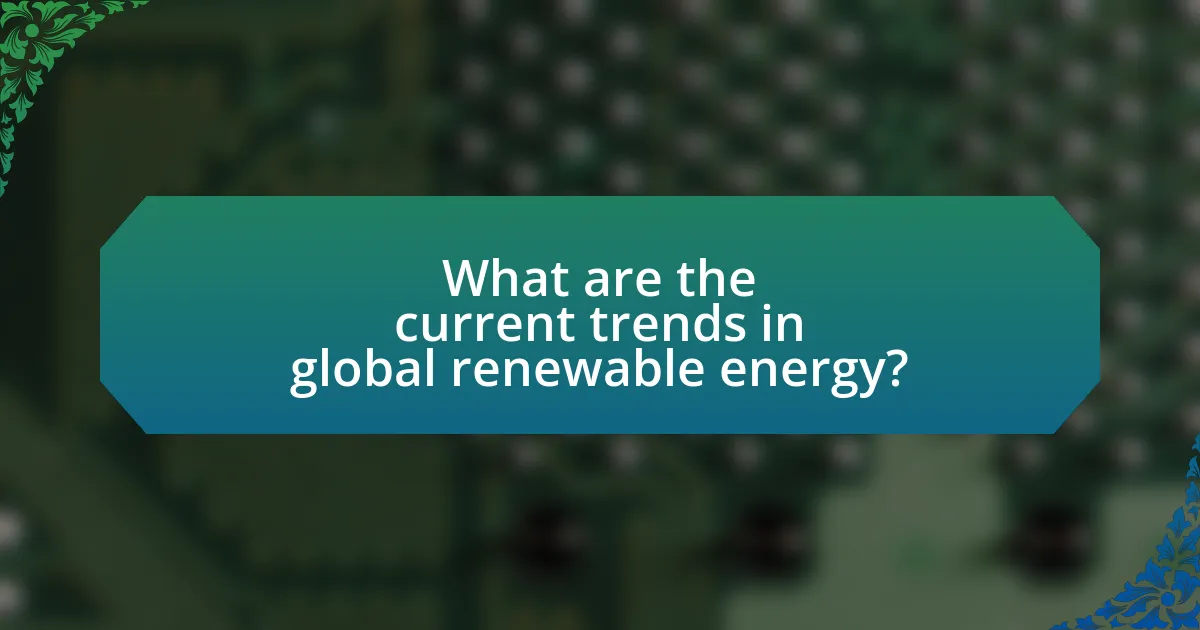
What are the current trends in global renewable energy?
Current trends in global renewable energy include a significant increase in solar and wind energy adoption, driven by technological advancements and decreasing costs. In 2022, solar power capacity grew by 24% globally, reaching over 1,000 gigawatts, while wind energy capacity increased by 13%, totaling approximately 900 gigawatts. Additionally, investments in renewable energy technologies are projected to exceed $2 trillion annually by 2030, reflecting a shift towards sustainable energy sources. The International Energy Agency reports that renewables are expected to account for nearly 95% of the increase in global power capacity through 2026, highlighting their central role in the transition to a low-carbon economy.
How is the adoption of renewable energy sources changing worldwide?
The adoption of renewable energy sources is rapidly increasing worldwide, driven by technological advancements, policy support, and growing environmental awareness. In 2022, renewable energy accounted for approximately 29% of global electricity generation, a significant rise from 26% in 2021, according to the International Energy Agency (IEA). This growth is particularly evident in solar and wind energy, which saw record installations, with solar capacity increasing by 24% and wind by 13% in the same year. Additionally, countries are setting ambitious targets for carbon neutrality, with over 130 nations committing to net-zero emissions by mid-century, further accelerating the transition to renewables.
What factors are driving the growth of renewable energy adoption?
The growth of renewable energy adoption is primarily driven by technological advancements, policy support, and economic factors. Technological advancements have significantly reduced the cost of renewable energy sources, such as solar and wind, making them more competitive with fossil fuels; for instance, the cost of solar photovoltaic systems has dropped by over 80% since 2010. Policy support, including government incentives and international agreements like the Paris Agreement, encourages investment in renewable energy projects. Economic factors, such as increasing energy demand and the need for energy security, further propel the transition to renewable sources, as countries seek to diversify their energy portfolios and reduce reliance on imported fuels.
How do government policies influence renewable energy trends?
Government policies significantly influence renewable energy trends by establishing regulatory frameworks, financial incentives, and targets for energy production. For instance, countries that implement feed-in tariffs or tax credits for renewable energy projects often see increased investment and deployment of technologies such as solar and wind power. According to the International Renewable Energy Agency (IRENA), nations with supportive policies have experienced a 20% annual growth rate in renewable energy capacity, demonstrating a direct correlation between policy support and market expansion. Additionally, commitments to international agreements, like the Paris Agreement, compel governments to adopt more aggressive renewable energy targets, further shaping industry trends and driving innovation.
What role do technological advancements play in renewable energy?
Technological advancements play a crucial role in enhancing the efficiency and viability of renewable energy sources. Innovations such as improved solar panel designs, advanced wind turbine technology, and energy storage solutions have significantly increased energy output and reduced costs. For instance, the efficiency of solar panels has improved from around 15% in the early 2000s to over 22% today, driven by advancements in materials and manufacturing processes. Additionally, the cost of wind energy has dropped by approximately 70% since 2009, largely due to technological improvements in turbine design and installation methods. These advancements not only make renewable energy more competitive with fossil fuels but also facilitate the integration of renewable sources into existing energy grids, promoting a more sustainable energy future.
Which technologies are leading the renewable energy revolution?
Solar photovoltaic (PV) technology and wind energy systems are leading the renewable energy revolution. Solar PV technology has seen a dramatic decrease in costs, with prices dropping by over 80% since 2010, making it one of the most affordable energy sources globally. Wind energy, particularly onshore and offshore wind farms, has also experienced significant advancements, with global installed capacity reaching over 700 gigawatts by 2020, according to the Global Wind Energy Council. These technologies are pivotal in reducing greenhouse gas emissions and transitioning to sustainable energy systems.
How do innovations in energy storage impact renewable energy use?
Innovations in energy storage significantly enhance renewable energy use by enabling better integration of intermittent energy sources like solar and wind into the power grid. Advanced storage technologies, such as lithium-ion batteries and flow batteries, allow for the capture and retention of excess energy generated during peak production times, which can then be utilized during periods of low generation. For instance, the International Energy Agency reported that energy storage capacity has increased by over 50% from 2018 to 2020, facilitating a more reliable energy supply and reducing reliance on fossil fuels. This increased capacity not only stabilizes the grid but also promotes the adoption of renewable energy technologies, ultimately leading to a more sustainable energy future.

What predictions can be made about the future of renewable energy?
The future of renewable energy is predicted to see significant growth, with global renewable energy capacity expected to reach 4,800 gigawatts by 2030, according to the International Renewable Energy Agency (IRENA). This growth is driven by advancements in technology, decreasing costs of solar and wind energy, and increasing government policies aimed at reducing carbon emissions. For instance, the cost of solar photovoltaic (PV) systems has dropped by over 80% since 2010, making solar energy more accessible and competitive with fossil fuels. Additionally, the global investment in renewable energy is projected to exceed $2 trillion annually by 2030, reflecting a strong commitment to transitioning towards sustainable energy sources.
How will renewable energy sources evolve in the next decade?
Renewable energy sources will significantly evolve in the next decade through advancements in technology, increased efficiency, and expanded adoption. The International Energy Agency (IEA) projects that global renewable energy capacity will grow by over 60% from 2020 to 2026, driven by solar and wind energy. Innovations in energy storage, such as improved battery technologies, will enhance the reliability and integration of renewables into the energy grid. Additionally, government policies and investments in clean energy infrastructure will accelerate the transition away from fossil fuels, with many countries committing to net-zero emissions targets by 2050. This shift is supported by the growing economic competitiveness of renewables, as the cost of solar photovoltaic systems has decreased by 82% since 2010, making them more accessible.
What are the expected advancements in solar and wind energy?
Expected advancements in solar and wind energy include increased efficiency, enhanced energy storage solutions, and improved integration with smart grid technologies. For solar energy, innovations such as bifacial solar panels and perovskite solar cells are projected to boost efficiency rates beyond 25%, as evidenced by research from the National Renewable Energy Laboratory. In wind energy, advancements in turbine design, including larger rotor diameters and higher hub heights, are anticipated to increase energy capture and reduce costs, with studies indicating that offshore wind farms could generate up to 50% more energy than onshore installations. These developments are crucial for meeting global renewable energy targets and addressing climate change.
How might the energy grid adapt to increased renewable energy integration?
The energy grid might adapt to increased renewable energy integration by enhancing grid flexibility and implementing advanced energy management systems. These adaptations include the deployment of smart grid technologies, which facilitate real-time monitoring and control of energy flows, allowing for better integration of variable renewable sources like solar and wind. According to the International Energy Agency, smart grids can improve efficiency and reliability, enabling a higher percentage of renewables to be incorporated into the energy mix without compromising stability. Additionally, energy storage solutions, such as batteries, are crucial for balancing supply and demand, as they store excess energy generated during peak production times for use during low production periods. This combination of smart technologies and storage capabilities is essential for a resilient energy grid that can accommodate the growing share of renewable energy.
What challenges will the renewable energy sector face in the future?
The renewable energy sector will face challenges such as technological integration, regulatory hurdles, and supply chain constraints in the future. Technological integration involves the need for advanced energy storage solutions and smart grid systems to manage intermittent energy sources like solar and wind effectively. Regulatory hurdles include navigating complex policies and incentives that vary by region, which can hinder investment and deployment. Additionally, supply chain constraints, particularly for critical materials like lithium and rare earth elements used in batteries and solar panels, may impact production and scalability. According to the International Energy Agency, achieving net-zero emissions by 2050 will require a significant increase in renewable energy capacity, highlighting the urgency of addressing these challenges.
What are the potential economic barriers to renewable energy expansion?
The potential economic barriers to renewable energy expansion include high initial capital costs, market volatility, and insufficient financial incentives. High initial capital costs deter investment, as renewable energy projects often require significant upfront funding for technology and infrastructure. Market volatility affects the stability of energy prices, making it challenging for investors to predict returns on investment. Insufficient financial incentives, such as tax credits or subsidies, limit the attractiveness of renewable energy compared to fossil fuels, which often receive more favorable financial treatment. These barriers collectively hinder the growth and adoption of renewable energy technologies.
How might climate change impact renewable energy development?
Climate change may significantly impact renewable energy development by altering resource availability and increasing the frequency of extreme weather events. For instance, rising temperatures can affect the efficiency of solar panels and wind turbines, as higher ambient temperatures reduce their energy output. Additionally, climate change can lead to shifts in precipitation patterns, which may affect hydropower generation by altering water flow in rivers and reservoirs. According to the International Renewable Energy Agency, climate change poses risks to energy infrastructure, potentially leading to increased costs and reduced reliability in renewable energy systems.

What are the implications of renewable energy trends and predictions?
The implications of renewable energy trends and predictions include significant shifts in energy markets, environmental benefits, and economic opportunities. As countries increasingly adopt renewable energy sources, such as solar and wind, global energy demand is projected to transition away from fossil fuels, leading to a reduction in greenhouse gas emissions. For instance, the International Energy Agency (IEA) forecasts that renewable energy will account for nearly 95% of the increase in global power capacity through 2026, highlighting a major shift in energy infrastructure. This transition not only supports climate goals but also creates jobs in the renewable sector, with the International Renewable Energy Agency (IRENA) estimating that the sector could employ over 24 million people by 2030. Additionally, advancements in technology and decreasing costs of renewable energy systems are expected to enhance energy access in developing regions, further driving economic growth and sustainability.
How will renewable energy trends affect global economies?
Renewable energy trends will positively impact global economies by driving job creation, reducing energy costs, and fostering technological innovation. The International Renewable Energy Agency (IRENA) reported that the renewable energy sector employed over 11 million people worldwide in 2018, with projections suggesting this number could reach 24 million by 2030 as investments in clean energy technologies increase. Additionally, the decreasing costs of solar and wind energy, which have dropped by 89% and 70% respectively since 2009, will lead to lower energy prices for consumers and businesses, stimulating economic growth. Furthermore, the transition to renewable energy sources encourages innovation in energy storage and smart grid technologies, which can enhance energy efficiency and reliability, further benefiting economies globally.
What industries are likely to be transformed by renewable energy growth?
The industries likely to be transformed by renewable energy growth include the energy sector, transportation, manufacturing, and agriculture. The energy sector is undergoing a significant shift as renewable sources like solar and wind power replace fossil fuels, leading to a decrease in carbon emissions and a more sustainable energy grid. In transportation, electric vehicles are gaining traction, driven by advancements in battery technology and the expansion of charging infrastructure, which reduces reliance on gasoline and diesel. Manufacturing processes are also evolving, with companies adopting renewable energy to power operations, thereby lowering operational costs and enhancing sustainability. Agriculture is being transformed through the integration of renewable energy solutions, such as solar-powered irrigation systems, which improve efficiency and reduce environmental impact. These transformations are supported by global trends towards decarbonization and sustainability, as evidenced by the International Energy Agency’s report indicating that renewable energy capacity is expected to grow significantly in the coming years.
How can businesses prepare for the shift towards renewable energy?
Businesses can prepare for the shift towards renewable energy by conducting comprehensive energy audits and investing in renewable technologies. Energy audits help identify current energy consumption patterns and inefficiencies, enabling businesses to target areas for improvement. Investing in renewable technologies, such as solar panels or wind turbines, can reduce reliance on fossil fuels and lower operational costs over time. According to the International Renewable Energy Agency, renewable energy sources are projected to account for 86% of global power demand by 2050, highlighting the urgency for businesses to adapt. Additionally, forming partnerships with renewable energy providers can facilitate access to innovative solutions and financing options, further supporting the transition.
What practical steps can individuals take to support renewable energy?
Individuals can support renewable energy by adopting energy-efficient practices and utilizing renewable energy sources. For instance, installing solar panels on residential properties can significantly reduce reliance on fossil fuels, as solar energy accounted for approximately 3% of total U.S. electricity generation in 2020, according to the U.S. Energy Information Administration. Additionally, individuals can choose to purchase green energy from their utility providers, which often includes energy generated from wind, solar, and hydroelectric sources. Engaging in energy conservation measures, such as using LED lighting and energy-efficient appliances, further contributes to reducing overall energy consumption. By advocating for policies that promote renewable energy development and participating in community initiatives, individuals can amplify their impact on the transition to a sustainable energy future.
How can consumers make informed choices about renewable energy sources?
Consumers can make informed choices about renewable energy sources by researching the types of renewable energy available, understanding their environmental impacts, and comparing costs and benefits. For instance, consumers should evaluate solar, wind, hydroelectric, and geothermal energy options based on their local availability and efficiency. According to the U.S. Department of Energy, solar energy can reduce electricity bills by up to 70% in some regions, making it a financially viable option. Additionally, consumers can consult resources like the Energy Information Administration, which provides data on energy sources and their environmental effects, helping them to assess the sustainability of their choices.
What are the best practices for adopting renewable energy at home?
The best practices for adopting renewable energy at home include conducting an energy audit, investing in solar panels, utilizing energy-efficient appliances, and considering home battery storage. Conducting an energy audit helps identify areas for improvement in energy consumption, allowing homeowners to optimize their energy use. Investing in solar panels can significantly reduce electricity bills and carbon footprint; for instance, the U.S. Department of Energy reports that solar energy can lower energy costs by 50% or more. Utilizing energy-efficient appliances reduces overall energy demand, as these devices consume less power compared to standard models. Additionally, home battery storage systems enable homeowners to store excess energy generated from renewable sources, providing backup power and enhancing energy independence.
